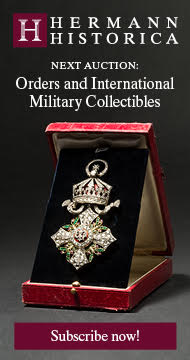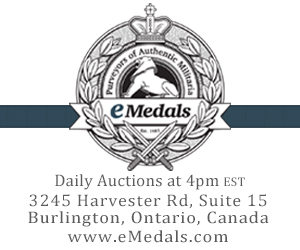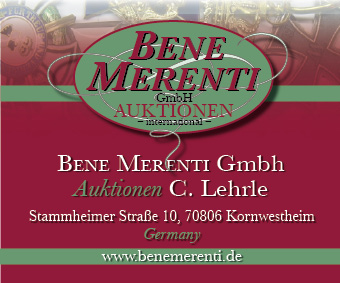Luftwaffe Flying Troops NCO/EM Ranks Cloth Tunic
CATEGORY: Version
SKU: 22.GOR.02.01.01.02.003.000
Estimated market value:



Estimated market value:
The tunic is fabricated from bluish-gray wool. The shoulders are adorned with shoulder straps trimmed in angled yellow-gold cord and are held firmly in place by gilt aluminum buttons at one end and sewn in place at the opposite end, where they meet the sleeve seam. The full-length of the collar is trimmed in an angled yellow-gold cord, with both collar tabs in yellow-gold wool and without cyphers. The right breast exhibits an embroidered light gray Luftwaffe eagle insignia, with the lower tip of the insignia overlapping the pocket below. The front has four large pockets, one on each breast, with slightly larger pockets below each, all with decorative straps giving them a pleated-look with gilt aluminum buttons at the top. The front is completed by a vertical row of four gilt aluminum buttons on the right side, facing an equal number of reinforced button holes on the left. All buttons on the tunic are maker marked "GEBR. BALDAUF MARIENBERG" on their reverses. There are aluminum loops on either side at the waist for a matching belt, the belt having been lost to time, while the rear of the tunic is single-vented. The tunic has been designed with a tapered-fit in mind, as evidenced by seven vertical seams, two on the front and the other five on the sides and rear. The sleeves have been designed to be buttonless and have French cuffs. Inside, the body of the tunic is lined throughout in a grayish-brown cotton, with upward-pointing aluminum belt loops covered by cotton straps on both sides at the waist and large loops attached at the seams in the armpits. There is a cotton lined pocket on the left breast, with various marks in black ink above the pocket, including "42", "72", "102", "53", "LBA37" and "Brago", plus additional stamps in black ink on the pocket itself, the top one partially legible due to a large "X" having been inscribed on it but "K.K. II Schönwalde" clearly visible, the other mark inscribed "A.L. Gr. J. 1938" in a large rectangle. The tunic measures 480 mm across the shoulders x 740 mm in length.
The German Wehrmacht was composed of three main branches, the Heer, the Kriegsmarine, and the Luftwaffe. The Heer and Kriegsmarine uniforms were based upon the designs utilized by their predecessor organizations, the Deutsches Heer and the Kaiserliche Marine. Conversely, the Luftwaffe uniforms were based upon the uniforms worn in the sports and para-military organizations that were the forerunners of the Luftwaffe. The Luftwaffe uniforms were specifically designed to deviate from the designs of the other Wehrmacht service branches. It was also necessary that the uniforms differentiate between military and civilian pilots.
There were two main organizational precursors of the Luftwaffe, the German Air Sports Association (DLV or Deutscher Luftsportverband), and the National Air Raid Protection League (RLB or Reichs Luftschutzbund). The DLV included both a civilian group and a secret military sub-group called the DLV-Fliegerschaft (Pilot Base).
The DLV and the RLB were officially founded in 1933, and they were used to secretly train members for future roles in the Luftwaffe. The DLV became obsolete after Hitler’s official introduction of the Luftwaffe in 1935, and it was disbanded in 1937.
The Cloth Tunic, also known as the Service Tunic, was first introduced for wear by the DLV, and its design continued to be worn by personnel in the Luftwaffe as part of the standard service uniform until the end of the Second World War. In 1935, the tunic was given the designation “Tuchrock”.
This tunic is single-breasted with an open collar and composed of several main elements, including the cloth, the pockets, the buttons, the collar lining, the belt hooks, and the additional insignia.
The tunic is made of blue-grey cloth, which is composed of a wool-rayon blend for NCO/EM ranks (Non-Commissioned Officers/Enlisted Men), and of high-quality gabardine for Officers.
There should be four patch pockets in total, with a rectangular flap closure that is closed by a button.
This tunic features four buttons along the front, either silver-coloured for Officers and NCO/EMs, or gold-coloured for Generals. The buttons on the pockets follow the same colour pattern.
The collar of these tunics is lined in piping that matches the wearer’s arm of service (Waffenfarbe) for all NCO/EMs until March 20, 1940. After March 20, 1940, the collars of the tunics of all NCO/EM ranks were not lined. The collars of Officers are lined in a twisted silver-aluminum cord, while the collars of Generals are lined in a twisted gold-coloured cord.
A simplified overview of the Waffenfarbe colours follows. Not all of these will appear on the NCO/EM tunics.
White: General Officers
Golden-Yellow: Flying Troops (Fliegertruppe)
Red: Anti-Aircraft Troops/Luftwaffe Artillery
Brown: Luftwaffe Signals/Communication Corps (Luftnachrichtentruppe)
Black: Reich Air Ministry, Construction Engineer Corp (Baupioniere) or Luftwaffe Engineer Corp (Luftwaffen-Pioniere)
Dark Green: Administration (Militärverwaltung)
Light/Meadow Green: Radar Units and Air Traffic Control
Dark Blue: Luftwaffe Medical Corps (Sanitätstruppe)
Light Blue: Transport Units (Transporteinheiten) or Luftwaffe Reserve
Carmine: General Staff Service Officers (Generalstabsoffiziere) and Veterinary NCOs/EMs
Pink: Corps of Engineer Officers (Ingenieuroffizierkorps)
Wine Red: Military Judicial Officers (Militärgerichtsbarkeit)
There are two internal belt hooks included within the waistline of the service tunic.
There are several types of insignia worn on these tunics, including the embroidered breast eagle above the top right pocket, the collar tabs, and the shoulder boards.

Comments
Sign in to comment and reply.


Scroll Top